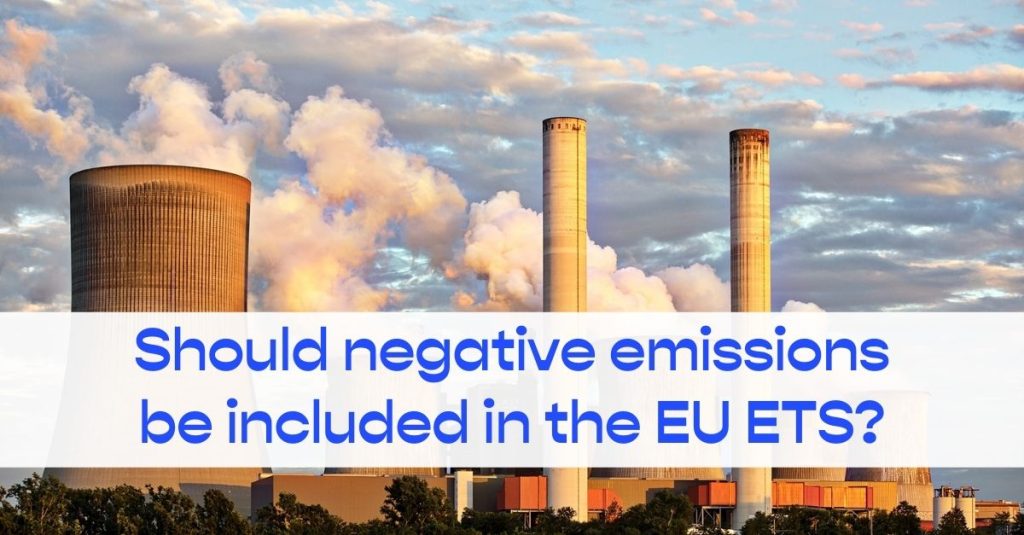
Let’s take a closer look at how removals are included in Europe’s sectoral climate policies today, what kind of proposals are currently on the table, and the options to include carbon removal in climate policy tools like the European Union Emissions Trading System.
Where are the removals included today?
The three pillars of the European Union climate policy are:
1) European Union Emissions Trading System (EU ETS), which covers 40% of the emissions;
2) Effort Sharing Regulation (ESR) covering 60% of the emissions (non-ETS sectors);
3) Land Use, Land Use Change and Forestry Regulation (LULUCF) which removes more emissions than it emits – a net sink on the European level.
The scope of these pillars would change substantially with the proposals under the FitFor55 package, leaving 40% of emissions covered by the EU ETS, 40% by the EU ETS II (buildings and transport) and 20% by the ESR.
The EU ETS, the world’s most successful cap and trade system where the carbon price was close to three digits in early 2022, is designed to incentivise emission reductions, not removals. Nevertheless, it includes one tool to incentivise technology-based removals — project financing through the Innovation Fund. The size of the Innovation Fund, which at 450 million allowances might generate close to 40 billion EUR in funding at today’s carbon price, is substantial. Nonetheless, the 20-fold oversubscription for large scale projects and ten-fold for small scale projects indicates that the demand vastly exceeds supply. The vast majority of the funding will, for the foreseeable future, be allocated to emission reduction projects to help meet Europe’s climate targets.
The ESR establishes country-level emission reduction targets in sectors that the EU ETS does not cover. Given that emissions from biomass and waste incineration are excluded from the scope of the EU ETS*, bioenergy with carbon capture and storage (BECCS) and Waste-to-Energy with CCS are under the ESR. We have yet to see any carbon removal reported from such projects because none are operational yet. However, this is poised to change in the coming years. The ESR also has another link with removals – countries can use a limited transfer of removal credits from LULUCF to meet their ESR targets.
The LULUCF regulation covers emissions and removals from land use, land-use change and forestry and is the primary policy tool to increase removals in Europe. However, it does not cover technology-based (and other more novel) carbon removal approaches. The new proposal seeks to reverse the current trend of shrinking carbon sinks in Europe and increase carbon removal.
New proposals
The European Union’s sectoral climate policies are currently being revised, and different suggestions are emerging to incorporate technology-based removals in one way or another.
The draft report on the revision of the EU ETS by the European Parliament’s responsible committee features an amendment to reward carbon removal with BECCS, direct air capture with carbon storage (DACCS) and certain types of carbon capture and utilisation with the EU ETS allowances.
In a parallel policy-making process on the ESR, the draft report by the European Parliament’s responsible committee suggests including technology-based (as opposed to biosphere-based) removal approaches under the ESR while limiting the use of such removals to 5% of a national target under the ESR. Additionally, the Parliament proposes an additional safety reserve composed of surplus removals generated by the Member States over their LULUCF targets.
Discussions on including removals in these legislative files have received much attention from stakeholders, and the landscape of possible solutions is constantly evolving.
Should negative emissions be included in the EU ETS?
Should the EU ETS be expanded from the Emissions Trading System to the Emissions and Removals Trading System? There are many advantages to doing it. The European Climate Law establishes a net-zero emissions target by 2050, followed by (net) negative emissions. Without policy tools to scale up removals, it’s not possible to get to net negative emissions territory.
The linear reduction factor in the EU ETS, a mechanism that reduces the cap of emissions covered by the system every year, would get to zero sometime after 2057 based on the current EU ETS rules, and a decade or so earlier in the context of recent more ambitious climate targets. For EU ETS installations, the inclusion of removals would allow more liquidity for the years when the system’s cap is getting closer to zero. However, a lot depends on the design of how the carbon removals are included.
For carbon removal project developers, the main advantage for including removals within the EU ETS is allowing removal activities to benefit from its carbon price. However, this only applies to those approaches that the carbon price can incentivise. Without additional support from other measures like Carbon Contracts for Difference, the EU ETS could work for BECCS and waste-to-energy with CCS, but not DACCS.
There are three main ways to include removals in the EU ETS if the system is not completely redesigned to differentiate between the climate impact of emissions and removals:
1) through the inclusion of new activities in Annex I of the EU ETS Directive, or
2) by allowing the use of carbon removal certificates from outside the EU ETS for compliance in the EU ETS. An example of this, although without the domestic nor carbon removal aspect, is the use of international credits within the EU ETS which took place before 2020, or
3) the combination of the two options above.
The first option will not allow putting in place limitations on the quantity. All options allow to make quality and time-related choices (what types of removals and from when), and there is an abundance of possible governance arrangements that could be used, especially for the second and third options.
There will always be an alternative not to include removals within the EU ETS and build a separate horizontal policy tool through the certification of carbon removals. All policy options have their challenges and lists of pros and cons.
Why is it complicated?
As with all other policy choices involving cutting emissions and increasing removals, it’s critical to address the “moral hazard” question so the availability of carbon removal doesn’t reduce the urgency to cut emissions. The EU ETS is a cap and trade system, and its cap, together with the linear reduction factor, defines the system’s ambition. As it is a domestic system, offsets from other parts of the world don’t have an impact.
To include removals whilst not increasing the cap, the removals need to be incorporated under the system’s cap (unless the system is fundamentally changed), for example through a specific reserve. This solution would treat removals similarly to emission reductions without recognising their different climate impact. In its current architecture, the cap of the EU ETS is divided between the allowances available to the companies (either for free or via auctioning) and different types of reserves and funds. The latter group includes the Innovation Fund, Modernisation Fund, Special Reserve for Aircraft Operators, New Entrants Reserve, and to some extent, the Market Stability Reserve.
Every time a new reserve or fund is included under the same cap, the number of allowances available for installations decreases, provided that the size of all the other funds and reserves remains the same. While the share of removals in the EU ETS stays low, it’s a plausible way forward. The cap of 2021 is 1.5 billion allowances. A reserve that would incentivise achieving 5 million tonnes for technology-based removals in 2030 (the aspirational target in the Sustainable Carbon Cycles communication) is not unrealistic.
Allowing the cap to be increased by the number of removals added to the system, as opposed to fitting the removals under the cap, can disincentivise emission reductions. There is also an option to limit the access to removals only to those companies/sectors that are unlikely to cut their emissions to zero – those with a certain amount of expected residual emissions. Still, it’s unlikely to alleviate the “moral hazard” concerns over the next couple of decades.
A long list of other considerations adds to the complexity, many of these related to different governance options.
Carbon Pricing is not the only tool
Including removals in the EU ETS, EU ETS II on transport and buildings or ESR, against the backdrop of currently prepared Carbon Removal Certification Mechanism, is only one aspect to consider. As highlighted above, the carbon price of the EU ETS will only help to scale up those carbon removal approaches that fit in the price range, provided that the policy and regulation are in place and carbon storage infrastructure is built out fast enough. The business case for more expensive solutions will need to be built with additional incentives.
There are many helpful policy tools available in addition to carbon pricing. Carbon contracts for difference, feed-in tariffs, public procurement of carbon removal could already be introduced by policymakers today. There is no need to wait for the inclusion in the sectoral climate policies, which might only kick in from 2030.
Key considerations
Scaling up removals whilst keeping the pressure on to reduce emissions requires a careful approach. The following four considerations are essential:
1) Quantity: the level of removals to be included (if any)
2) Quality: the type of removals to be included, starting with carbon removal approaches where robust accounting rules exist. In the EU, technology-based removals are considered for the EU ETS and ESR, land-based are within the LULUCF.
3) Timing: when to phase in removals, finding the balance between being thorough in the policy design and not rushing, and getting the policy tools ready in time to scale up removals
4) Governance: the “how” of including removals. The role of governments and companies. How should the policies like the EU ETS be redesigned? Where do the allowances come from?
For other jurisdictions, geographical considerations would be another vital aspect. However, the EU’s climate targets are domestic, and therefore the scope is contained to emission reductions and removals within the European Economic Area.
Further reading recommendations:
La Hoz Theuer, S., Doda, B., Kellner, K. and Acworth, W. (2021). Emission Trading Systems and Net Zero: Trading Removals. Berlin: ICAP.
Sign up for updates below and stay tuned for the next posts!
* – Sweden and Denmark have included waste incineration under the EU ETS and will be able to benefit from its carbon price for the emission reduction (but not carbon removal) part of future waste-to-energy with CCS plants.
***
Would you like to use (parts of) the text? Go ahead on the condition that you explicitly refer to this post and include a link.
Thank you!

